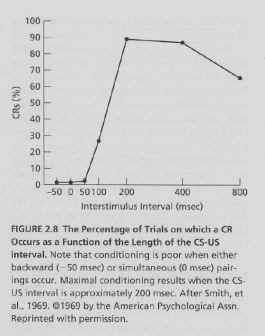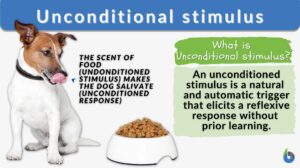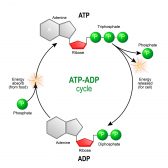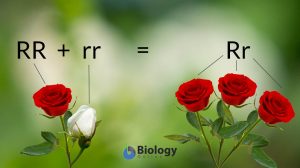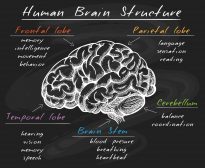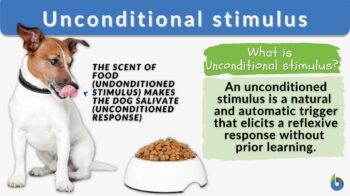
Unconditioned stimulus
n., plural: unconditioned stimuli
[ʌnkənˈdɪʃ ənd ˈstɪm.jə.ləs]
Definition: Innate trigger for a response
Table of Contents
An unconditioned stimulus inherently triggers an automatic response, not reliant on deliberate prior learning. In contrast to a conditioned stimulus, the unconditioned stimulus doesn’t need to begin as neutral, nor must it undergo pairing with another stimulus to gain unconditioned status. It inherently provokes innate reactions.
The concepts of conditioned and unconditioned stimulus are fundamental to the classical conditioning process, a type of learning process identified by Ivan Pavlov and extensively studied in the field of psychology. There are different types of stimuli in the natural world namely neutral, conditioned, and unconditioned stimuli. And to each of these stimuli, living beings produce some or the other response.
So, there are different types of responses to these stimuli namely conditioned and unconditioned responses. Note that not all types of stimuli and responses fit neatly into this framework, especially in more complex scenarios than the classical conditioning paradigm or other areas of psychology and biology.
Here, we will deal with the unconditioned stimulus and how this unconditioned stimulus in classical conditioning works, and what type of response this unconditioned stimulus produces. Read on to learn more.
What Is An Unconditioned Stimulus?
An unconditioned stimulus (UCS) is characterized as a stimulus that naturally and automatically triggers a response without the need for prior learning. This concept was notably demonstrated by Ivan Pavlov who employed a straightforward illustration. For instance, Pavlov identified the scent of presenting food as an unconditioned stimulus (UCS) for dogs.
When this stimulus is consistently present, the natural outcome (reflexive response) is the dog’s salivation (dog’s physical reactions), an unconditioned response (UCR). This reaction is inherent to the dog and does not necessitate deliberate training.
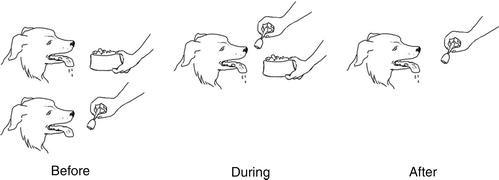
In contrast to a conditioned stimulus, the unconditioned stimulus need not be an initially neutral stimulus before its establishment as an unconditioned stimulus. Also, it requires no pairing with any other stimulus to be established as an unconditioned stimulus.
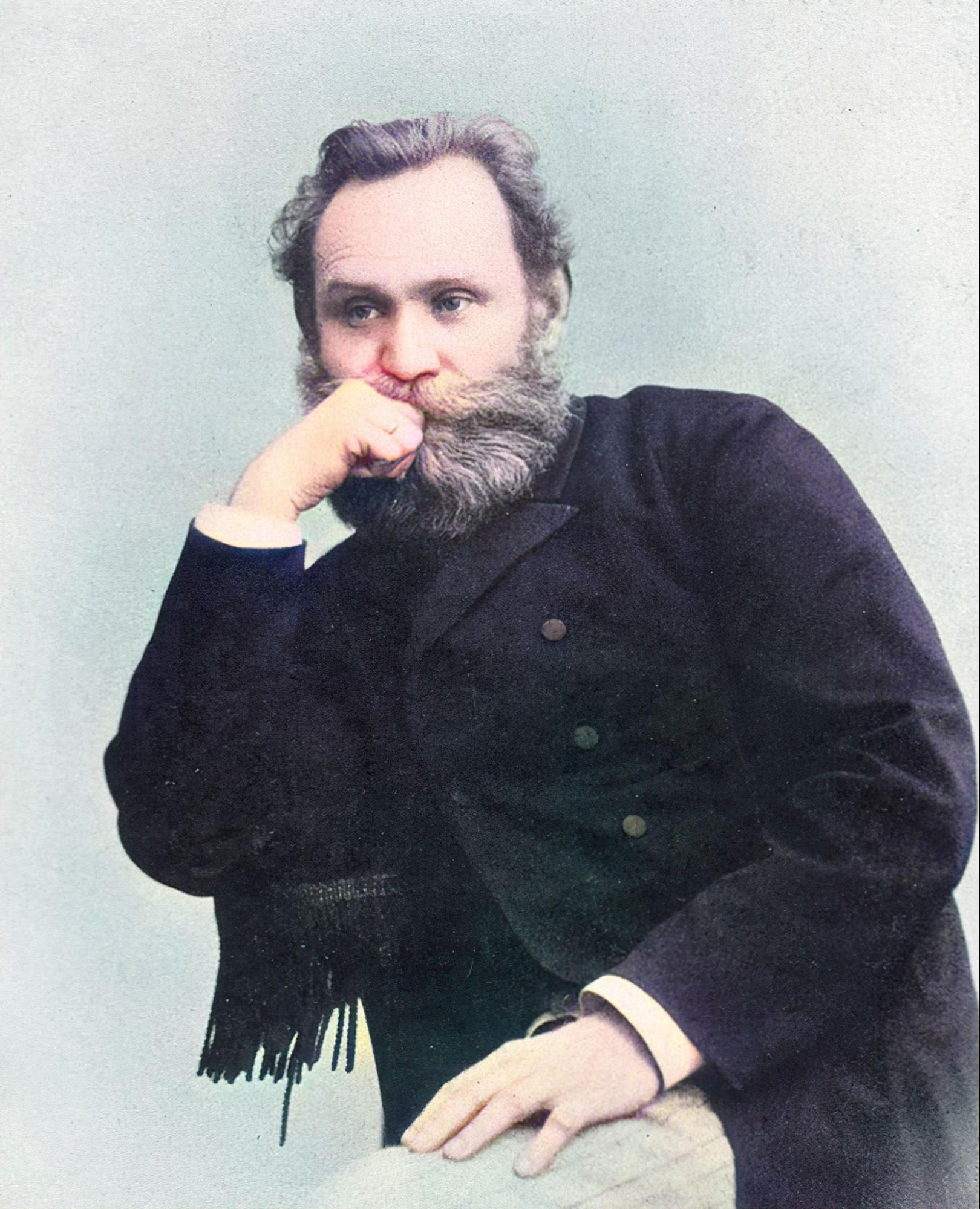
Unconditioned Stimulus and Classical Conditioning
Classical conditioning constitutes a form of learning wherein a neutral stimulus becomes linked with a meaningful unconditioned stimulus. This subsequently causes the neutral stimulus to induce a response akin to (or the same response) that is produced by the unconditioned stimulus.
The renowned Russian physiologist Ivan Pavlov extensively researched this process, employing dogs as subjects to illuminate their behavioral tendencies. This psychological principle stands as a cornerstone shedding light on the acquisition and alteration of behaviors and emotional reactions. Its practical implications span domains like therapy, education, and advertising.
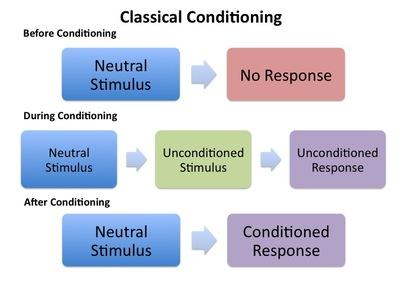
Look at the table below to find the main differences between the 3 types of stimuli.
Table 1: Differences between the 3 types of stimuli | |||
|---|---|---|---|
| Aspect Conditioned Stimulus (CS) | Conditioned Stimulus | Unconditioned Stimulus | Neutral Stimulus (NS) |
| Definition | A previously neutral stimulus that acquires the ability to trigger a response after being paired with an unconditioned stimulus | A stimulus that naturally and automatically triggers a specific response without any prior learning | A stimulus that does not elicit a particular response on its own and has no inherent connection to the response being studied |
| Role in Learning | Develops through association with an unconditioned stimulus and leads to the formation of a conditioned response. | Initiates an unconditioned response without any prior learning, serving as a basis for creating associations. | Serves as a starting point for classical conditioning, becoming the conditioned stimulus after pairing with an unconditioned stimulus. |
| Example | Bell ringing in Pavlov’s dog experiment becomes the conditioned stimulus after the conditioning process | The smell of food in Pavlov’s dog experiment | Bell ringing in Pavlov’s dog experiment is the neutral stimulus before the conditioning process |
| Association | Gains significance and elicits a learned response due to repeated pairings with an unconditioned stimulus | Naturally and automatically triggers a specific, unlearned response | Acquires significance and triggers a response through pairing with an unconditioned stimulus |
| Type of Response | Triggers a conditioned response that is learned through association | Triggers an unconditioned response that is innate and automatic | Initially does not trigger a response, but later elicits a conditioned response |
| Nature of Response | The response may be similar to the unconditioned response but not as intense. | A natural, unlearned response that is automatic and consistent | The response is acquired and learned through conditioning, similar to the unconditioned response. |
Data Source: Akanksha Saxena of Biology Online
Watch this vid about unconditioned stimulus:
Biology definition:
An unconditioned stimulus is a natural and automatic trigger that elicits a reflexive response without prior learning. In classical conditioning, it is a type of stimulus that evokes an unconditioned response. For example, food as an unconditioned stimulus causes a hungry animal to salivate. Salivation is the unconditioned behavioral response.
Importance of Temporal Proximity and Pairing of Unconditioned Stimulus with Neutral Stimulus
During conditioning, the neutral stimulus (NS) is presented in close “temporal proximity” to the unconditioned stimulus (UCS). This “pairing” is repeated multiple times.
Conditioning and Temporal Proximity
Temporal proximity refers to “the closeness or nearness in time” between two events or stimuli. In the context of classical conditioning, it means that the neutral stimulus (NS) and the unconditioned stimulus (UCS) are presented very close together in time. When we say that the neutral stimulus is presented in close temporal proximity to the unconditioned stimulus, we mean that they are presented almost simultaneously or very shortly after each other.
This close timing is crucial for the process of classical conditioning because it “helps in the establishment of an association between the neutral stimulus (NS) and the unconditioned stimulus (UCS)”.
The brain starts linking the 2 stimuli together, and this over time leads to the neutral stimulus triggering a response (called conditioned response now) quite similar to the natural response (unconditioned response; UCR) evoked by the unconditioned stimulus.

Conditioning and Pairing
The number of pairings required to establish classical conditioning can vary based on several factors including the organisms being studied, the specific stimuli involved, and the nature of the response being conditioned.
There is “no fixed or specific number of pairings” that applies universally to all situations.
In some cases, classical conditioning can occur relatively quickly, while in other cases, it might require more repetitions. The process of pairing the neutral stimulus (NS) with the unconditioned stimulus (UCS) is typically repeated until a consistent conditioned response (CR) is observed.
Factors that can influence the speed and effectiveness of classical conditioning include:
- Intensity of Stimuli: Stronger or more intense stimuli may lead to faster conditioning.
- Timing: The closer the timing between the NS and UCS presentations, the more effective the conditioning tends to be.

Figure 5: The percentage of trials on which a cr occurs as a function of the length of the cs-us interval. Image Credit: Minnesota State University - Consistency: Regular and consistent pairings are more likely to result in successful conditioning.
- Organism and Experience: Different organisms may vary in how quickly they form associations, and prior experiences can also play a role.
- Nature of the Response: Some responses are easier to condition than others. For example, physiological responses like dogs salivating or eyeblink conditioning might occur faster than complex emotional responses.
- Biological Factors: Individual differences in genetics and brain function can affect the speed of conditioning.
Researchers typically conduct experiments to determine the optimal conditions for classical conditioning based on the specific variables they are studying. The goal is to find the right balance between the NS and UCS presentations to create a strong and reliable conditioned response. (Figure 5)
NOTE IT!
Importance of Unconditioned Stimulus and Unconditioned Response in Classical Conditioning
Unconditioned stimulus (UCS) and unconditioned responses (UCR) play a fundamental role in the process of classical conditioning. They are “essential components of the learning mechanism” that enables neutral stimuli to become conditioned stimuli (CS) capable of eliciting conditioned responses (CR). This process underlies how organisms adapt to their environment and acquire new behaviors and reactions.
The basis for Association: Unconditioned stimuli and responses provide the natural, inherent link that serves as the foundation for creating associations between neutral stimuli and responses. The unconditioned stimulus triggers an unconditioned response without any prior learning.
Learning Process: Classical conditioning is a learning process facilitated by the continuous pairing of a neutral stimulus with an unconditioned stimulus to produce a conditioned response. The presence of an unconditioned response helps establish and strengthen this association ensuring that associative learning occurs.
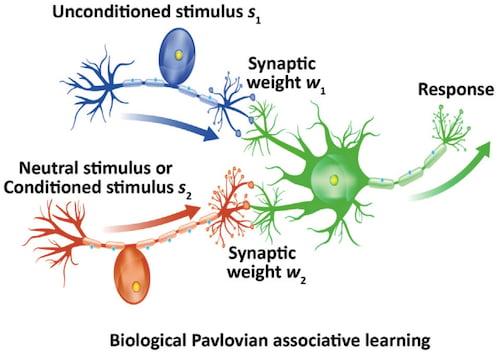
Transfer of Meaning: Through the process of classical conditioning, the meaning of the unconditioned stimulus is transferred to the neutral stimulus which becomes the conditioned stimulus. This transfer allows the neutral stimulus to evoke a response that was initially only produced by the unconditioned stimulus.
Testing and Measurement: Unconditioned responses provide a benchmark for measuring the effectiveness of conditioning. They serve as a point of comparison to determine whether the conditioned response has been successfully learned and established.
Study of Behavior Modification: By understanding the principles of classical conditioning involving unconditioned stimuli and responses, psychologists and researchers can explore ways to modify behaviors and emotional responses. Conditioning can be used to reduce or alleviate unwanted responses through techniques like exposure therapy.
Understanding Conditioned Emotional Reactions: Many emotional reactions, such as disgust, aversive conditioning (due to an aversive stimulus like a smell, sound, or crime), or fear conditioning, are associated with unconditioned stimuli and responses. Classical conditioning helps explain how these emotional responses can be learned and modified through the pairing of stimuli.
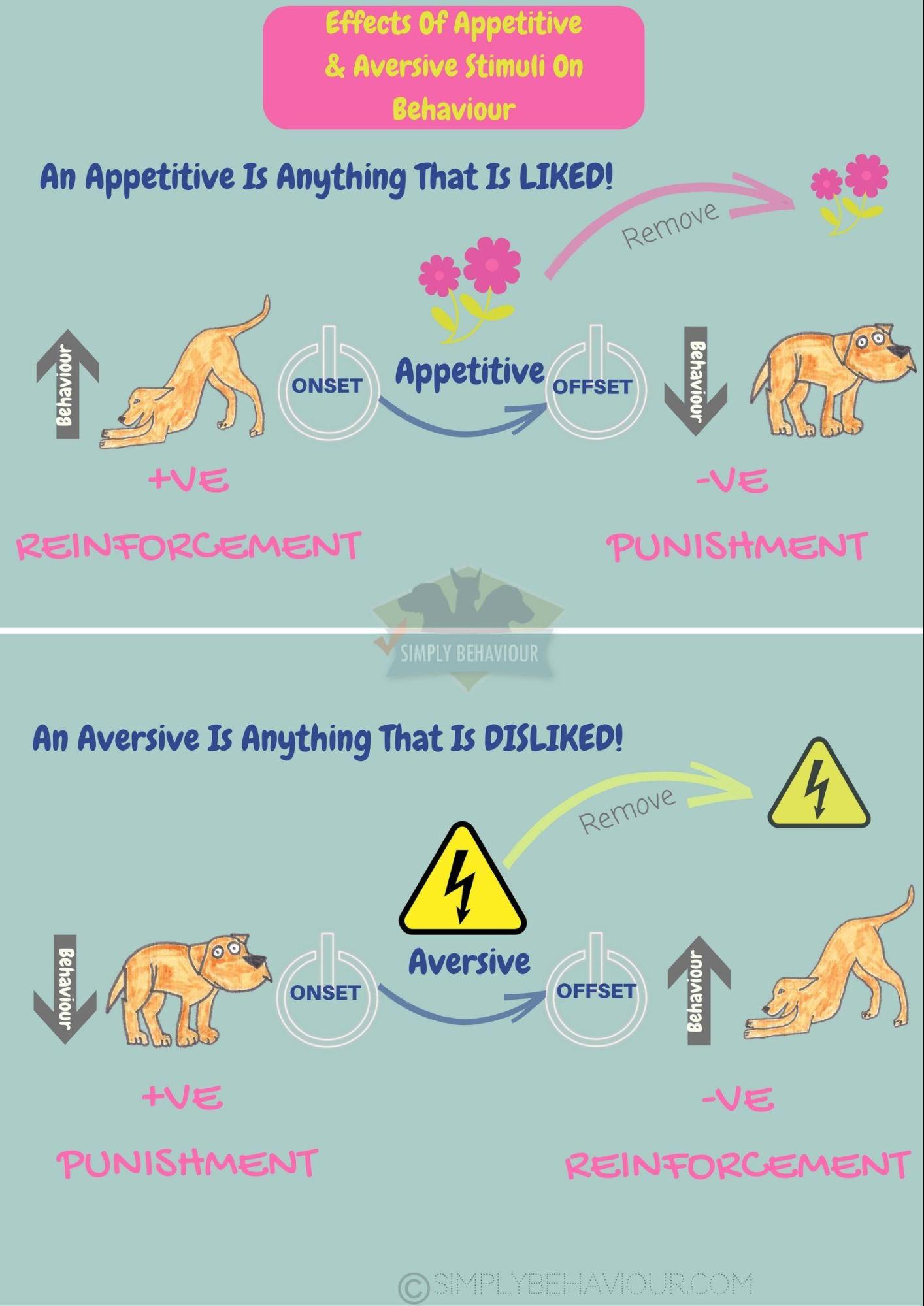
Research and Experimentation: The study of unconditioned stimuli and responses in controlled experimental settings has contributed to our understanding of how behaviors can be shaped, modified, and influenced by external stimuli.
Examples Of Unconditioned Stimulus
There are several examples of unconditioned stimulus like Pavlov’s Experiment, the Little Albert (Watson & Raynor) Experiment, etc to explain the idea of unconditioned stimulus to learners.
Pavlov’s Dogs Experiment
Ivan Petrovich Pavlov (1849–1936) was a Russian physiologist and psychologist best known for his groundbreaking research in the field of classical conditioning. His work laid the foundation for our understanding of how learning and behavior are influenced by associations between stimuli and responses. Pavlov’s contributions had a profound impact on the field of psychology and have practical applications in various areas.
Classical Conditioning: Pavlov’s most significant contribution was the discovery of classical conditioning, often referred to as “Pavlovian conditioning” established by his series of experiments with dogs where he observed how neutral stimuli (such as the sound of a bell) could become associated with physiological responses (such as salivation) when paired with an unconditioned stimulus (such as the smell of food). This led to the development of a systematic understanding of how behaviors and responses could be learned through associations.
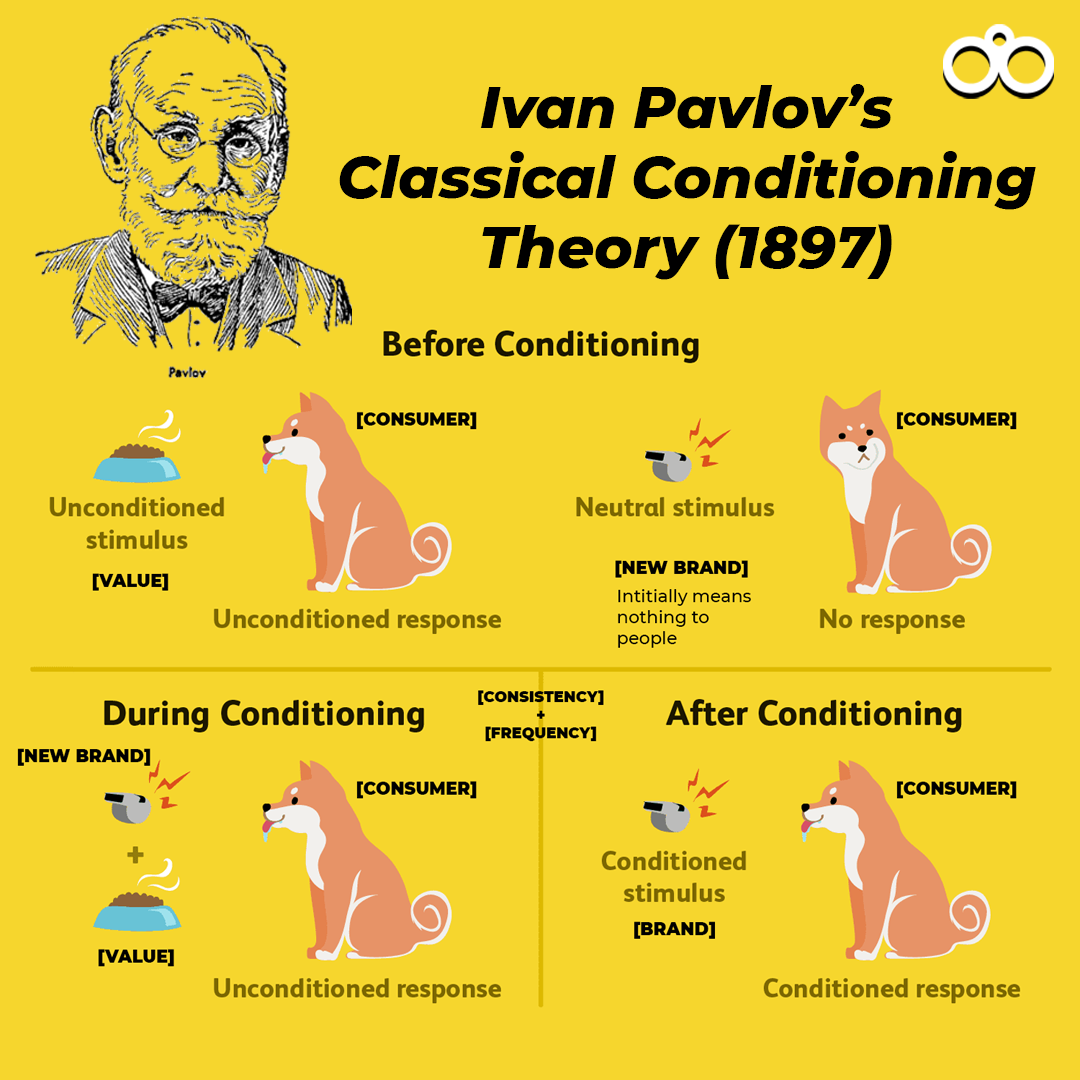
Pavlov’s research helped differentiate between unconditioned responses (natural, innate responses to stimuli) and conditioned responses (learned responses resulting from associations). He demonstrated how a neutral stimulus could become a conditioned stimulus by pairing it with a conditioned stimulus.
Pavlov’s rigorous experimental approach including careful control over variables and systematic observations set a standard for scientific research in psychology. His work emphasized the importance of objective measurement and replicable experimentation.
In 1904, Pavlov was awarded the Nobel Prize in Physiology or Medicine for his work on the “physiology of the digestive glands”. While his Nobel recognition was not specifically for his research on classical conditioning, his contributions to psychology and learning are equally significant.
Little Albert (Watson & Raynor) Experiment
The “Little Albert” experiment conducted by John B. Watson and his graduate student Rosalie Rayner in 1920 is a classic example of classical conditioning and its application to the development of phobias. This experiment involved a young boy named Albert and a white rat. It demonstrated how fear responses could be learned through the process of classical conditioning. Read the brief experimental overview.
» Initial Responses: At the beginning of the experiment, Little Albert showed no fear of a white rat or other similar objects and animals.
» Pairing the Stimuli: During the experiment, the researchers presented Little Albert with the white rat (neutral stimulus) and simultaneously produced a loud, startling noise (unconditioned stimulus) by striking a steel bar with a hammer behind the boy’s head. This noise (unconditioned stimulus) naturally triggers fear (unconditioned response).
» Conditioning: After multiple pairings of the white rat exposure to the loud noise, Little Albert started displaying “signs of fear” (in the form of crying, and crawling away). This was happening even when the boy was presented with the rat alone (now a conditioned stimulus). The fear response had become a conditioned response.
» Generalization: Little Albert’s fear response generalized to other similar stimuli like a white rabbit, a fur coat, and even a white Santa Claus mask. This demonstrated how a fear response could extend to stimuli that were similar to the original conditioned stimulus.
Significance and Critiques: The Little Albert experiment is significant for several reasons:
- Classical Conditioning: The experiment vividly illustrated how classical conditioning can lead to the acquisition of fear responses to previously neutral stimuli.
- Ethical Concerns: The experiment has also faced significant ethical criticism due to the potential emotional harm inflicted on Little Albert and the lack of informed consent from his parents.
- Generalization and Phobias: The findings helped researchers understand the process of stimulus generalization and the development of phobias in humans.
- Behaviorism: The experiment was conducted within the framework of behaviorism, a psychological perspective that focuses on observable behaviors and their conditioning.
- Practical Applications: The experiment’s principles have been applied to the treatment of phobias through exposure therapy, where individuals are exposed to feared stimuli to reduce their fear responses.
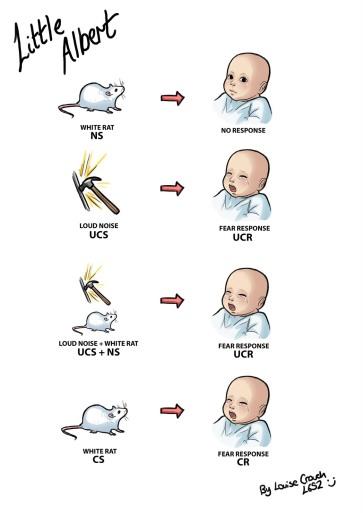
Smoking
In the context of addiction, the concept of a conditioned stimulus (CS) is related to classical conditioning and plays a significant role in the development and maintenance of addictive behaviors. In addiction as in smoking, a conditioned stimulus is a previously neutral stimulus that becomes associated with the rewarding effects of smoking or any other addictive behavior. This association can lead to the conditioned stimulus itself triggering cravings, anticipation, and even physiological responses similar to those produced by the drug or addictive behavior and major consequences on mental health. We briefly discuss how it works in the case of smoking.
Example in Addiction: Consider a person who smokes cigarettes. In this scenario:
- » UCS: Smoking a cigarette leads to pleasurable effects and relief from nicotine withdrawal symptoms.
- » UCR: The person experiences pleasure and relief from withdrawal symptoms when smoking a cigarette.
- » NS: Certain environmental cues, like seeing a particular place or being around friends who smoke may initially be neutral.
- » Pairing: The environmental cues (NS) are consistently paired with smoking (UCS).
- » CS: Eventually, the environmental cues become a conditioned stimulus (CS) capable of triggering cravings and anticipation of smoking (CR) even without the presence of an actual cigarette.
The process of conditioning significantly contributes to the cycle of addiction by rendering cues and situations linked to smoking “potent instigators of cravings and relapse”. Grasping the significance of conditioned stimuli in addiction is vital for formulating impactful treatment approaches. Approaches like exposure therapy and cognitive-behavioral therapy (CBT) offer valuable tools to assist individuals in handling and mitigating conditioned responses to cues that activate addictive behaviors.
Are Neutral Stimulus Really “Neutral” in Case of Smoking???
In the case of smoking, this is a very important point. In some cases, what might initially seem like a neutral stimulus might not be entirely neutral, especially in the context of addictive behaviors like smoking? In situations involving addiction, certain stimuli that appear neutral at first glance can have some level of significance or association with the addictive substance or behavior.
For example, in the context of smoking:
- » A particular location where someone often smokes could become associated with the act of smoking and the pleasurable effects of nicotine.
- » Social situations where smoking frequently occurs could trigger thoughts and cravings for cigarettes.
- » Specific sensory cues such as the smell of tobacco smoke or the sight of a cigarette pack might not be truly neutral for someone with a history of smoking.
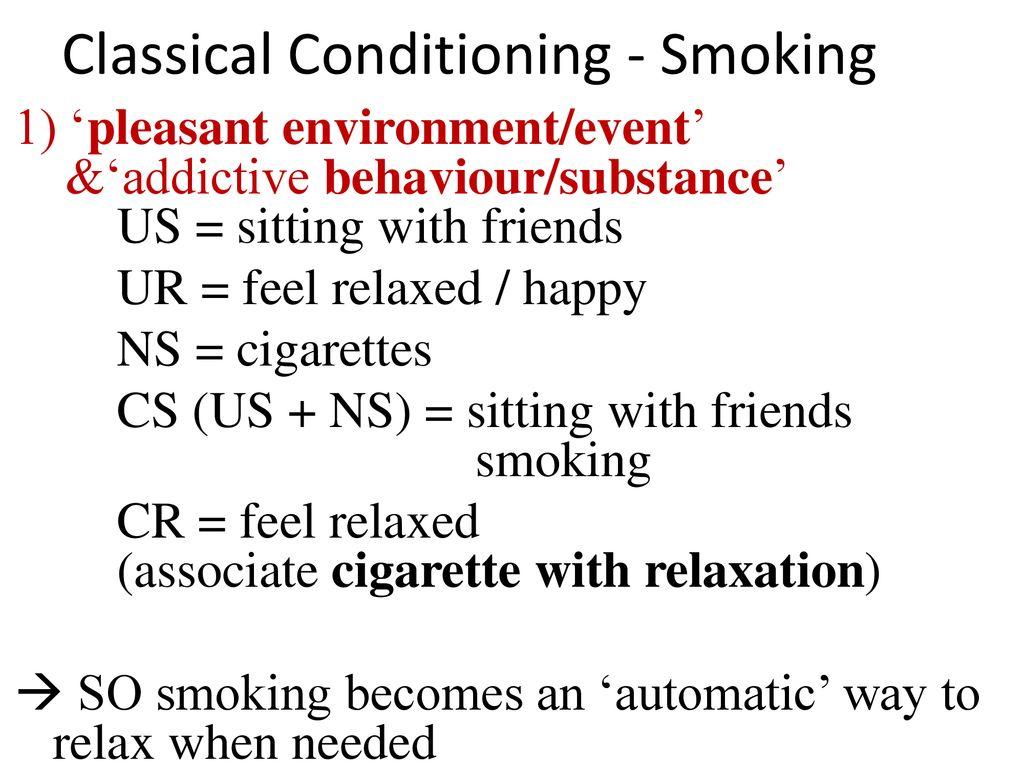
In these cases, these stimuli are not completely neutral as they have become associated with the pleasurable effects and rituals of smoking. They can act as conditioned stimuli that trigger conditioned responses, such as cravings, anticipation, or even physiological changes, like increased heart rate.
A true neutral stimulus in the context of smoking would be a stimulus that has no inherent or pre-existing connection to smoking, nicotine, or the act of smoking. It would not trigger any specific thoughts, feelings, or responses related to smoking in individuals who do not smoke or have not been exposed to smoking-related cues.
It’s important to note that in the real world, truly neutral stimuli can be difficult to find because most environments are filled with various cues and associations. Additionally, individuals who are exposed to smoking-related cues, even if they do not smoke themselves might develop some level of association with those cues over time. In the context of addiction, where associations with the addictive substance or behavior are already established, it becomes more challenging to identify neutral stimuli because many cues and situations might already have acquired some level of significance.
So, while the term “neutral stimulus” is used in the context of classical conditioning, it’s important to recognize that in real-world situations, many stimuli that are considered neutral in a broader context “might have acquired some level of significance or association” due to past experiences, especially in the context of addiction. This is why understanding the role of conditioned stimuli and their associations is crucial when addressing addictive behaviors and designing effective interventions or treatments.
Take the Unconditioned Stimulus – Biology Quiz!
References
- Coon, D., & Mitterer, J. O. (2010). Introduction to psychology: Gateways to mind and behavior (12th ed.). Wadsworth, CA: Wadsworth Cengage Learning.
- Staats, C. K., & Staats, A. W. (1957). Meaning established by classical conditioning. Journal of experimental psychology, 54(1), 74.
- Bouton, M. E., Mineka, S., & Barlow, D. H. (2018). A modern learning theory perspective on the etiology of panic disorder. The Neurotic Paradox, Vol 2, 265-324.
- Allen, C. T., & Madden, T. J. (1985). A closer look at classical conditioning. Journal of consumer research, 12(3), 301-315.
- Honey, R. C., & Dwyer, D. M. (2022). Higher-order conditioning: A critical review and computational model. Psychological Review, 129(6), 1338.
- Lanuza, E., Nader, K., & Ledoux, J. E. (2004). Unconditioned stimulus pathways to the amygdala: effects of posterior thalamic and cortical lesions on fear conditioning. Neuroscience, 125(2), 305-315.
- Rehman, I., Mahabadi, N., Sanvictores, T., & Rehman, C. I. (2017). Classical conditioning.
- Estes, W. (Ed.). (2022). Handbook of learning and cognitive processes. Psychology Press.
- Montgomery, G. H., & Kirsch, I. (1997). Classical conditioning and the placebo effect. Pain, 72(1-2), 107-113.
- Mauk, M. D., Medina, J. F., Nores, W. L., & Ohyama, T. (2000). Cerebellar function: coordination, learning or timing? Current biology, 10(14), R522-R525.
- Riley, A., & Aubrey, K. (2022). Understanding and using educational theories. Understanding and Using Educational Theories, 1-100.
- Conditioned reflexes. London: Oxford University Press. Singh, D. (1993)
- Watson, J. B., & Rayner, R. (1920). Conditioned emotional reactions. Journal of experimental psychology, 3 (1)
- Vinci C. (2020). Cognitive Behavioral and Mindfulness-Based Interventions for Smoking Cessation: a Review of the Recent Literature. Current oncology reports, 22(6), 58. https://doi.org/10.1007/s11912-020-00915-w
- Killen, J. D., Fortmann, S. P., Schatzberg, A. F., Arredondo, C., Murphy, G., Hayward, C., Celio, M., Cromp, D., Fong, D., & Pandurangi, M. (2008). Extended cognitive behavior therapy for cigarette smoking cessation. Addiction (Abingdon, England), 103(8), 1381–1390. https://doi.org/10.1111/j.1360-0443.2008.02273.
©BiologyOnline.com. Content provided and moderated by Biology Online Editors.
